
hotline:
17715390137
Tel/Wechat:
18101240246 (Technology)
0512-68565571
Email:mxenes@163.com (Sales Engineer)bkxc.bonnie@gmail.com
Scan the code to follow or search the official account on WeChat:
2D Materials Fronrier After paying attention,
click on the lower right corner to contact us,
Enter enterprise WeChat.
Professional Services Online

已传文件:photo/1631586161.png
North Konami can provide MXene (can be customized)
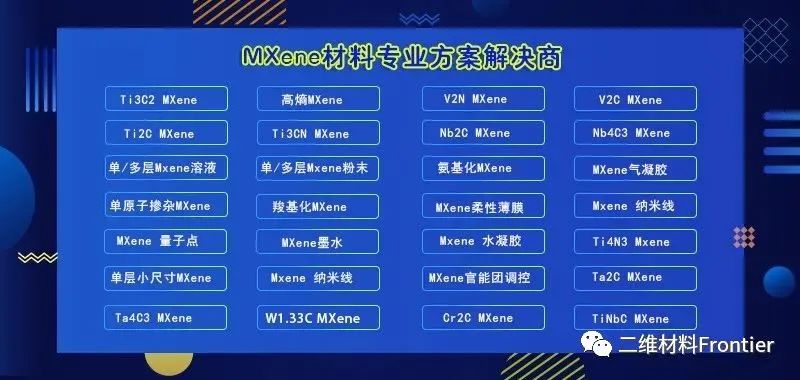
With the development of science and technology, energy storage devices with strong environmental adaptability and excellent high and low temperature performance have important research value in polar regions, deep space, high latitude and high altitude areas, military, aviation and other technical fields. With low cost and good low-temperature performance, Na-ion batteries have great potential in the field of energy storage. However, the slow kinetic properties and severe dendrite formation of the anode hinder the application of Na-ion batteries at low temperature. At low temperature, the storage of sodium ions in the anode material is a parallel reaction with the formation of dendrites on the surface of the material. Therefore, by adjusting the structure of the negative electrode material, promoting the rapid conduction of electrons and ions, and accelerating the transport of sodium ions in the bulk phase and interface, fast and stable storage of sodium ions at low temperatures can be achieved.
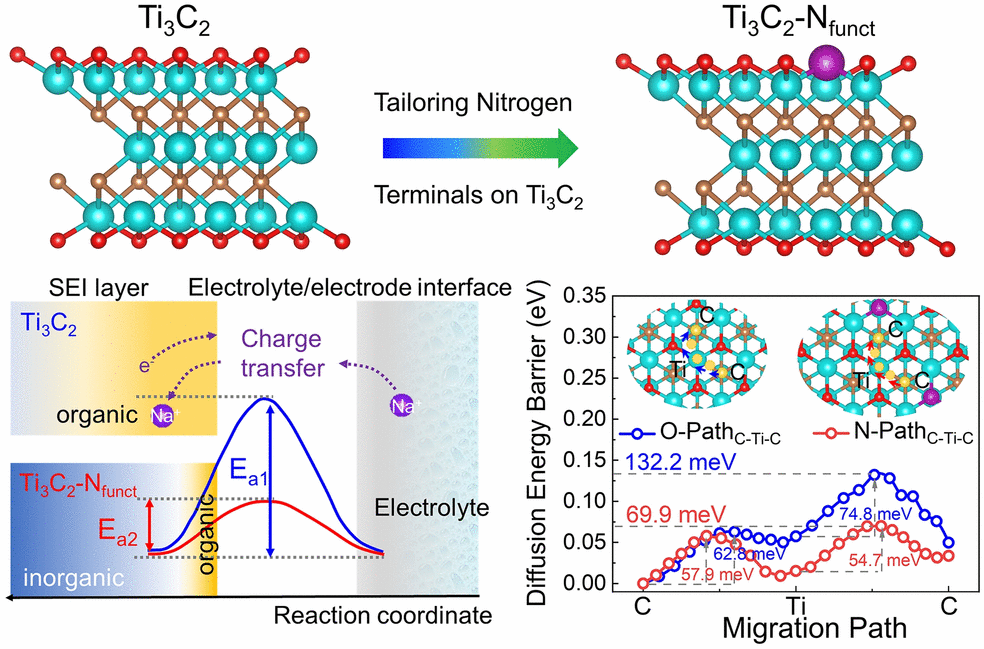
Tailoring Nitrogen Terminals on MXene Enables Fast Charging and Stable Cycling Na‑Ion Batteries at Low Temperature
Yang Xia, Lanfang Que *, Fuda Yu, Liang Deng, Zhenjin Liang, Yunshan Jiang, Meiyan Sun, Lei Zhao *, Zhenbo Wang*
Nano-Micro Letters (2022) 14: 143
https://doi.org/10.1007/s40820-022-00885-7
Highlights of this article
1. In this paper, an interlayer confinement strategy is proposed to realize the regulation of interlayer nitrogen groups in Ti₃C₂ MXene.
2. Compared with pristine Ti₃C₂, Ti₃C₂-Nfunct exhibits fast charging capability (80% capacity obtained after charging for 18 min) and excellent cycle life (80.9% capacity after 5000 cycles) at −25 °C.
3.Ti₃C₂-Nfunct not only has lower sodium ion diffusion barrier and charge transfer activation energy, but also has Na⁺-solvent co-intercalation behavior at low temperature.
brief introduction
Na-ion batteries have the potential to achieve fast charging and long life at low temperatures. However, sluggish kinetics and aggravated dendrite formation at low temperatures are two major challenges currently faced. In view of this, the research group of Professor Wang Zhenbo of Harbin Institute of Technology and the research group of Que Lanfang of Huaqiao University proposed an interlayer confinement strategy to achieve N group regulation between Ti₃C₂ MXene layers. Verified by density functional theory (DFT), the introduction of N groups enabled Ti₃C₂ with larger interlayer spacing compared to conventional O groups, induced surface charge redistribution, enhanced electrical conductivity and provided additional Na⁺ adsorption site. Ti₃C₂-Nfunct not only possesses lower sodium ion diffusion barrier and charge transfer activation energy, but also exhibits Na⁺-solvent co-intercalation behavior at low temperature, thus avoiding the higher desolvation energy barrier. In addition, the solid electrolyte interface (SEI) dominated by inorganic compounds is more favorable for the transfer of Na⁺ at the electrode/electrolyte interface. Therefore, compared with pristine Ti₃C₂, Ti₃C₂-Nfunct exhibits nearly twice the sodium storage capacity at low temperature, excellent fast charge rate performance and stable cycling performance. After being assembled with the Na₃V₂(PO₄)₂F₃ cathode to form a full battery, the Na-ion full battery also has high energy density and cycle stability.
Graphical guide
Preparation of I Ti₃C₂‑Nfunct MXene
Ti₃C₂ MXene has redox activity, excellent electron/ion transport ability and stable two-dimensional structure, which makes it have great potential as a battery anode material. However, unfavorable surface groups inhibit ion transport and charge storage capacity, limiting their applications.
In this paper, the interlayer confinement strategy was adopted: using cetyltrimethylammonium bromide (CTAB) as the nitrogen source, the Ti₃C₂ interlayers were pre-inserted in solution; then, under argon, the CTAB was thermally induced in the Ti₃C₂ interlayers. In situ decomposition; finally, the substitution of N groups is driven by heat to realize the regulation of surface N groups.
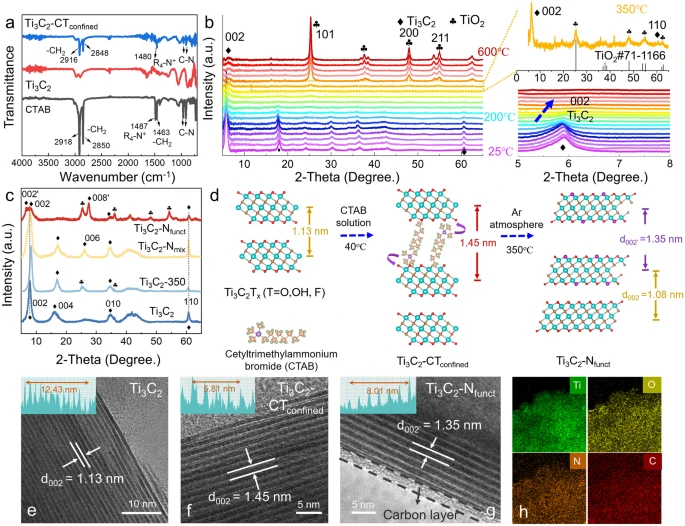
Fig. 1. (a) Fourier transform infrared spectra of CTAB powder, Ti₃C₂ and Ti₃C₂-CTconfined; (b) in-situ variable temperature XRD pattern of Ti₃C₂-CTconfined at 25-600℃ and enlarged image at 350℃; (c) Ti₃C₂, XRD patterns of Ti₃C₂-350, Ti₃C₂-Nmix and Ti₃C₂-Nfunct; (d) schematic diagram of the control process of Ti₃C₂; (e) high-resolution TEM images of Ti₃C₂, (f) Ti₃C₂-CTconfined and (g) Ti₃C₂-Nfunct; (h) ) Distribution of Ti, O, N and C elements on Ti₃C₂-Nfunct.
II Electronic Structure Analysis
Density functional theory (DFT) calculations show that after the introduction of N groups, N atoms transfer more charges to Ti atoms, which redistributes Ti₃C₂ surface charges, enhances electrical conductivity and provides additional Na⁺ adsorption sites.
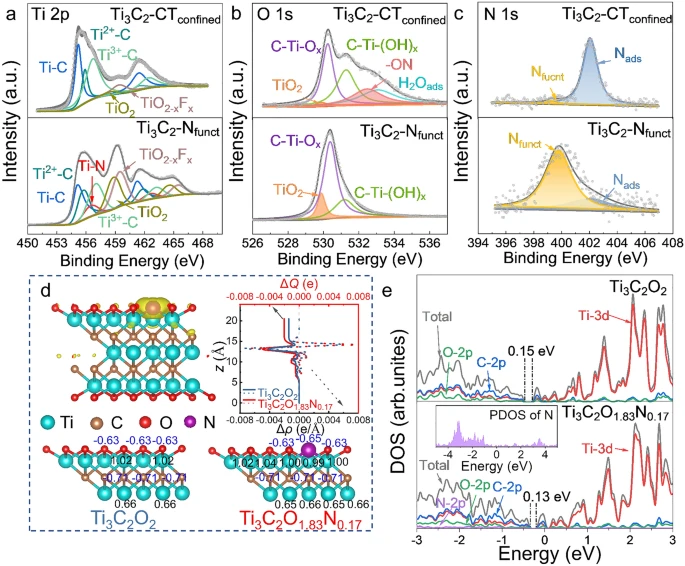
Figure 2. High-resolution (a) Ti 2p, (b) O 1s and (c) N 1s XPS spectra of Ti₃C₂-CTconfined and Ti₃C₂-Nfunct; (d) differential charge density map of Ti₃C₂O1.83N0.17, Ti₃C₂O2 and Ti₃C₂O1 .83N0.17 charge layout analysis; (e) DOS and pDOS of Ti₃C₂O₂ and Ti₃C₂O1.83N0.17 structures.
III Electrochemical performance at −25℃
Comparing the electrochemical properties of Ti₃C₂ and Ti₃C₂-Nfunct, Ti₃C₂-Nfunct exhibits nearly twice the specific capacity at room temperature and -25℃, and with the sharp decrease in temperature, Ti₃C₂-Nfunct still has 77% higher capacity than normal temperature. capacity retention. Ti₃C₂-Nfunct exhibits better rate performance and cycle performance. The Ti₃C₂-Nfunct anode and Na₃V₂(PO₄)₂F₃ cathode were assembled into a full cell. The full cell device exhibited a maximum energy density of 414.14 Wh kg⁻1 (based on the mass of the cathode material) at -25°C, and still 88.1% after 200 cycles at 0.5C capacity retention rate.
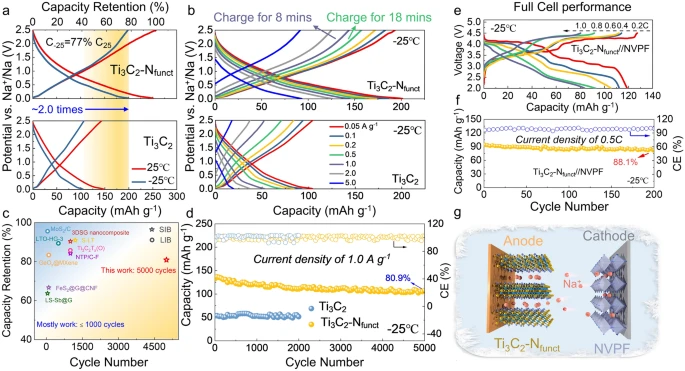
Figure 3. (a) The charge-discharge curves of Ti₃C₂ and Ti₃C₂-Nfunct in half-cell at 25℃ and -25℃; (b) the rate performance curve at -25℃; (c) and the currently reported materials at low temperature (d) cycle performance at -25 °C; (e) rate performance curve and (f) cycle performance of Ti₃C₂-Nfunct//NVPF full cell; (g) schematic diagram of Ti₃C₂-Nfunct//NVPF full cell.
Kinetic analysis of Ti₃C₂‑Nfunct anode at low temperature IV
The DFT calculation and experimental results show that the Na⁺ diffusion can be promoted by manipulating the N groups on the surface of Ti₃C₂. In the bilayer Ti₃C₂O₂ and Ti₃C₂O1.83N0.17 structures, Na⁺ migration favors the C-Ti-C pathway, among which the CA-Ti1-CB pathway in Ti₃C₂O1.83N0.17 has the lowest Na⁺ diffusion barrier. EIS at different temperatures shows that the activation energy of Ti₃C₂-Nfunct interface charge transfer process is nearly 10% lower than that of Ti₃C₂.
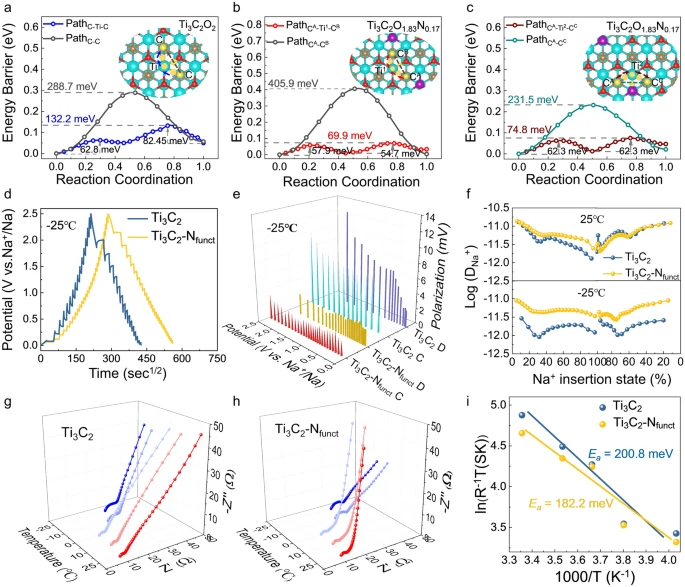
Figure 4. Diffusion energy barriers of Na⁺ on different paths in bilayer (a)Ti₃C₂O₂ and (b-c)Ti₃C₂O1.83N0.17 structures; (d) GITT original curves of Ti₃C₂ and Ti₃C₂-Nfunct at -25℃; (e) ) Comparing the polarization of Ti₃C₂ and Ti₃C₂-Nfunct during charge and discharge at -25℃; (f) comparing the Na⁺ diffusion coefficients of Ti₃C₂ and Ti₃C₂-Nfunct at 25℃ and -25℃; (g) at different temperatures Electrochemical impedance spectra of Ti₃C₂ and (h) Ti₃C₂-Nfunct; (h) Arrhenius plot of electrode charge transfer resistance (Rct) and corresponding activation energy (Ea).
Analysis of V-electrode interface composition
The composition analysis of the electrode surface by XPS shows that the organic-dominated SEI is formed on the Ti₃C₂ electrode, while the inorganic-dominated SEI is formed on the Ti₃C₂-Nfunct electrode. Benefiting from the low charge transfer resistance of inorganic SEI, the Ti₃C₂-Nfunct electrode should have a lower activation energy during the interfacial charge transfer process.
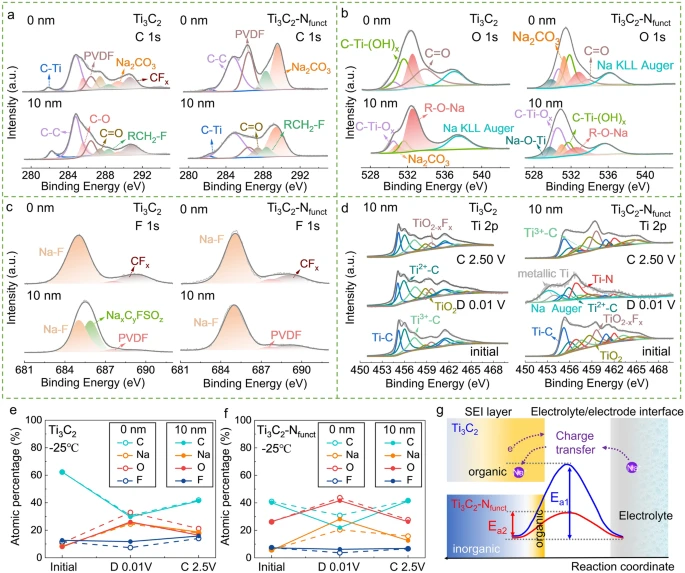
Figure 5. XPS etching analysis of the interface composition of Ti₃C₂ and Ti₃C₂-Nfunct electrodes at −25°C: (a)C 1s, (b)O 1s and (c) Ti₃C₂ and Ti₃C₂-Nfunct electrodes at the first discharge to 0.01 V ) F 1s XPS spectra; (d) Ti 2p spectra of Ti₃C₂ and Ti₃C₂-Nfunct electrodes after Ar⁺ etching for 10 nm at different SOCs; (e) Ti₃C₂ and (f) Ti₃C₂-Nfunct electrodes at different SOCs for C, Na , O, F and other elements; (g) Schematic diagram of SEI composition and charge transfer energy barriers formed on Ti₃C₂ and Ti₃C₂-Nfunct electrodes.
VI Study on the sodium storage mechanism of Ti₃C₂-Nfunct at low temperature
The sodium storage behavior of Ti₃C₂-Nfunct at low temperature was further studied by ex situ characterization. It is found that the solvent can intercalate between the Ti₃C₂-Nfunct layers at low temperature, and Na⁺ and the solvent have similar electrochemical behaviors. Therefore, it is speculated that Ti₃C₂-Nfunct has Na⁺-solvent co-intercalation behavior at low temperature, avoiding the desolvation process of high energy barrier, and then Ti₃C₂-Nfunct has a fast low-temperature sodium storage ability.
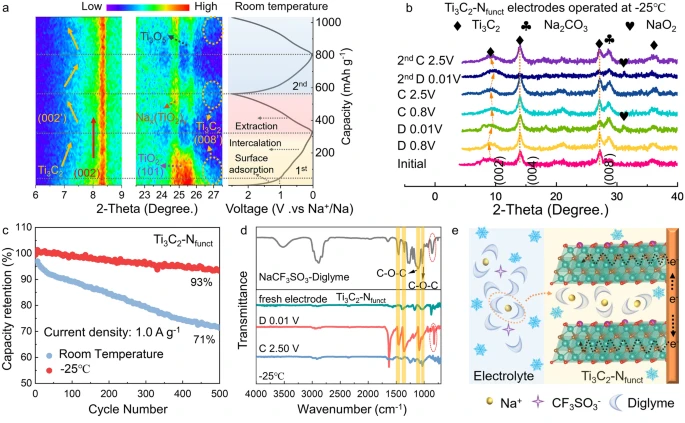
Fig. 6. (a) Electrochemical in-situ XRD patterns and corresponding charge-discharge curves of Ti₃C₂-Nfunct at 6.0°~9.0° and 22.5°~27.5° at room temperature; (b) Ti₃C₂-Nfunct electrode at −25°C In situ XRD patterns; (c) comparison of the cycling performance of Ti₃C₂-Nfunct electrodes at room temperature and low temperature; (d) ex-situ FTIR spectra of Ti₃C₂-Nfunct electrodes at −25°C; (e) Na⁺-Ti₃C₂-Nfunct electrodes at low temperature Schematic illustration of solvent co-intercalation behavior.

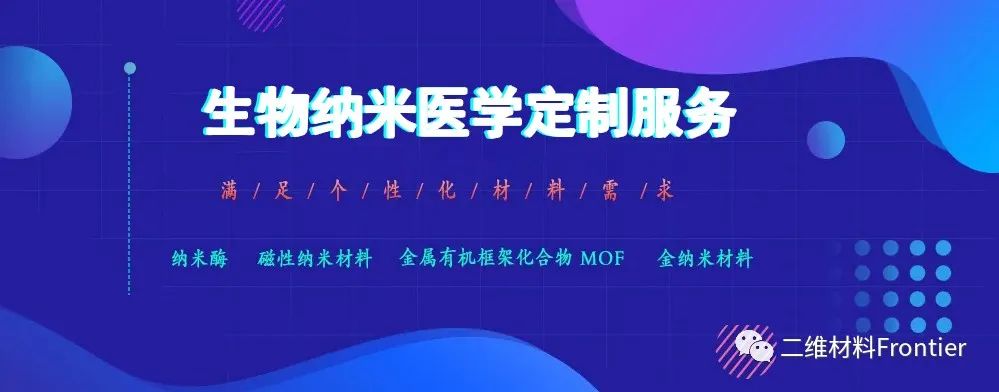
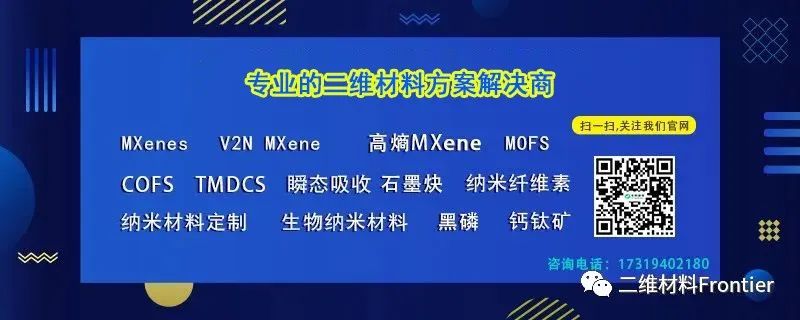

| Reminder: Beijing Beike New Material Technology Co., Ltd. supplies products only for scientific research, not for humans |
| All rights reserved © 2019 beijing beike new material Technology Co., Ltd 京ICP备16054715-2号 |